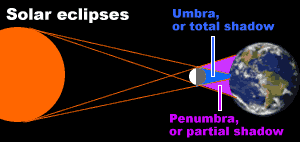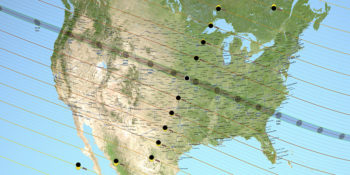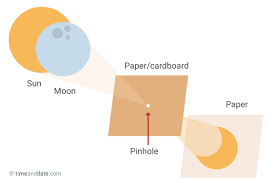Overview
On Monday, August 21, 2017, many people in North America will be able to see either a partial solar eclipse or a total solar eclipse, depending on where they live. Parts of South America, Africa, and Europe will also see a partial solar eclipse.
What Is an Eclipse?
During a solar eclipse, the moon passes between the earth and the sun. It blocks either all of the light from the sun or part of the light from the sun during the time it takes for the moon to travel across the face of the sun. The darkest portion of the moon’s shadow, the umbra, falls along a narrow path on the earth, for a total solar eclipse. The penumbra, or half of the moon’s shadow, falls on either side of the umbra. The sun is much larger than the earth or the moon, so it produces both umbra and penumbra.
Where Is the Path of Totality?
The path of totality is a 70 mile wide region that stretches from Lincoln Beach, OR through Oregon, Idaho, Wyoming, Montana, Nebraska, Iowa, Kansas, Missouri, Illinois, Kentucky, Tennessee, Georgia, and North and South Carolina. Other regions north and south of the path of totality will see a partial eclipse. Although the sun appears to be covered for about two minutes, the entire eclipse from start to finish takes about two hours. Many different websites on the Internet show whether the eclipse will be total or partial based on the location of the city.
What Are the Phases of a Solar Eclipse?
A partial eclipse begins when the sun appears to be partially blocked by the moon. That phase can last over an hour, and the sun looks like a partially-obscured crescent. The next phase before totality is often called the “diamond ring” because a single brilliant point of light shows at one place, while the corona of the sun forms a ring. The phase just before totality is referred to as “Baily’s beads” which are shining points of sunlight that are formed from the hills and valleys of the moon as it almost obscures the sun. During totality, the moon covers the entire disk of the sun and only the corona shows. In the final stages, the growing crescent sun shows as the moon moves away from blocking it. If the eclipse is a partial eclipse, none of the phases just before totality show.
How Can You See the Eclipse Safely?
Do not look at the sun directly without proper eye protection. Regular sunglasses do not provide enough protection, so special “eclipse glasses” are readily available. There are also many ways to view the eclipse indirectly, such as by using a sun funnel to reflect light coming from a telescope, projecting the image of the eclipse onto a screen, or use a pinhole projection.
Interested in science tutoring services? Learn more about how we are assisting thousands of students each academic year.
SchoolTutoring Academy is the premier educational services company for K-12 and college students. To learn more about how we help parents and students in Buckingham, QC, Canada: visit: Tutoring in Buckingham, QC




